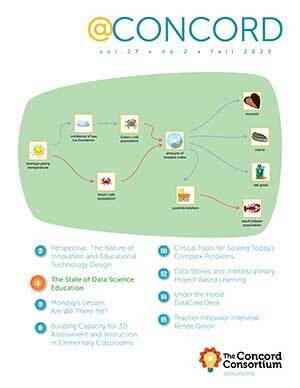News at Concord Consortium
The Concord Consortium is happy to announce the following new grants from the National Science Foundation.
Teaching Teamwork

Collaboration and communication are critically important skills in the 21st century STEM workforce, yet schools and colleges continue to reward students primarily for their individual test-taking ability, in part because assigning grades to separate team members is so difficult. In a new project with Tidewater Community College, CORD and ETS, we will teach electronics students how to work effectively in teams, both face-to-face and remotely. Students modify and measure realistic simulations of electronic components and circuit boards that are linked together over the Internet. They work on their own piece of the circuit and can see their teammates’ work. We will monitor students’ actions and communications, analyze the data and report on the performance of each individual student as well as that of the team as a whole.
Supporting Secondary Students in Building External Models
Although modeling is one of eight NGSS science and engineering practices, students rarely construct models in secondary science classrooms. Our goal is to create a systems modeling tool and instructional materials to support students in grades 6-12 in building and using models to explain and predict phenomena in a range of disciplines. The new modeling tool—plus data from Next-Generation Molecular Workbench simulations, sensor-based data from experiments and more—will be embedded in our Common Online Data Analysis Platform (CODAP), allowing students to manipulate and analyze multiple sources of data. As students compare the output of their own model with other data sources, they will revise their computational models and refine their conceptual models.
Enhancing Scientific Argumentation through Automated Feedback
With ETS and the University of California, Santa Cruz, we are developing automated scoring models for scientific argumentation for secondary school Earth science content on climate change and fresh water availability. An interactive score reporting system will provide customized individual feedback to students and class-level snapshots to teachers. Professional development resources will help teachers use automated diagnostics to improve instruction and assessment practices. We will investigate when and how feedback can be effective
in promoting learning.
Water SCIENCE
In our new Water SCIENCE project, middle school students from Arizona, Pennsylvania and Massachusetts will engage in project-based learning about water-related STEM topics and careers. Students will use the cameras built into tablet computers with an innovative mobile app to perform water quality analyses and aggregate results on a data-sharing platform. They will also design and conduct classroom engineering projects to improve water quality.
Teaching Environmental Sustainability
We are developing a new curriculum for high school environmental and geoscience classes around a GIS-based web application to analyze real data on environmental impacts regarding land use and water quantity and quality. We will update the Stroud Water Research Center’s Model My Watershed app with new environmental datasets and integrate new low-cost sensors to allow students to collect and upload local data. Students from urban and rural schools in five states across the U.S. will engage in a systems approach to problem solving through hands-on activities.
Embodied Explanatory Expressions
How does body movement support student reasoning about critical science concepts that have unseen structures and unobservable mechanisms? A new project seeks to identify types of body motion that enhance causal explanations for observable phenomena. With researchers at the University of Illinois at Urbana-Champaign we explore whether Embodied Explanatory Expressions (EEEs) can be integrated into the control structures of online simulations utilizing motion sensing input devices. The goal is to identify EEEs that support scientific reasoning in three areas of science with unseen mechanisms and structures: molecular interactions, heat transfer and Earth systems.
Like Us, Follow Us
We’re thrilled to have you as friends and followers. Get the latest updates on happenings at the Concord Consortium by following us on these sites.
